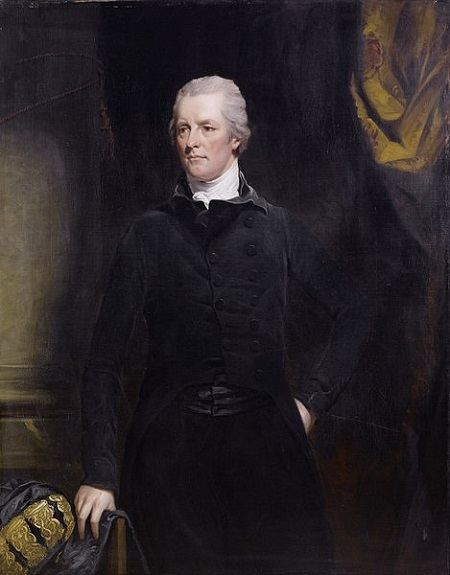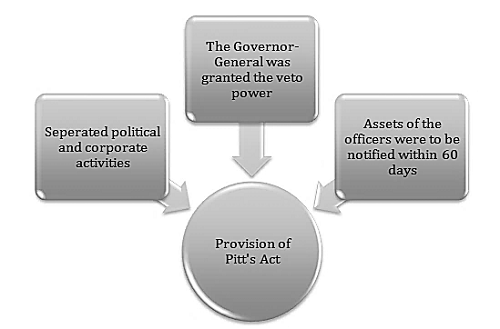

 The East India Act of 1784 was brought to the people of India by the Prime Minister of the United Kingdom. The Prime Minister is known to be the youngest in the history of this island nation in Europe. The person was a very young man as his age was merely 24 but had a very unique talent for producing capable administrative reforms. William Pitt was the person under whose guidance this act was eventually passed in the year 1784.
The East India Act of 1784 was brought to the people of India by the Prime Minister of the United Kingdom. The Prime Minister is known to be the youngest in the history of this island nation in Europe. The person was a very young man as his age was merely 24 but had a very unique talent for producing capable administrative reforms. William Pitt was the person under whose guidance this act was eventually passed in the year 1784.
Portrait of the Right Honourable William Pitt the Younger (1759-1806)
John Hoppner, Public domain, via Wikimedia Commons
The regulating Act of 1773 was analysed by the investigation of the Select and Secret Committee. These investigations were provided by analysing the bond that was shared by the Supreme Court of India and the Bengal Council. There was an investigation that was conducted by the Secret Committee to look into the causes that were eventually a factor leading to the war with the Marathas. The major reason to conduct this investigation was the financial distress that plunged the company into more debt.
This is the reason behind the fact that was able to state the causes which finally led to the formation of the act. Lastly, the act was able to share the control of the entire Indian subcontinent between the English East India Company and the Government of the United Kingdom. The mutual share over the control of India was very significant and was able to last for another year after the Revolt of Indian Independence.
The objective was to use the company of this island nation as an extension of the monarchy that was ruling the United Kingdom. This was the reason behind the fact that gives substantial evidence about the aspects of the company. The provisions of this act are used to draw a bridge between the activities of the company on the grounds of politics and corporatisation. The aspect of signing various affairs with the public and the administration of the company was brought under the tabs of the monarchy.

Figure 1: Key provisions of the Pitt’s Act, 1784
There was a Board of Control that was established as a formal body to monitor these proceedings conducted by the company. One of the most important key provisions of the company was that the Board was headed by a Secretary of the State. In the same manner, the company was placing a Board of Directors as their representative. These were some of the provisions that are important to the explanation of the Pitt’s India Act sanctioned in the last decades of the 18th century.
The significance of Pitt’s India Act is classified into two factors. These are some of the significant changes that were brought to the Indian subcontinent. All of these changes were able to bring the nation under the thumb of the British monarchy.
The first significance is associated with the causes on the grounds of a double governing system. In this event, the monarchy ruling over the United Kingdom was controlling India. The other body from the island nation was the EIC which was looking over various aspects apart from the grounds of public affairs and general administration.
The second factor was going to play a very significant role in bringing the monarchy much closer to the country. One of the most credible examples that are going to back this claim is the lands occupied by the company were called by a different name. The name was that these lands were not territories of the EIC anymore. On the contrary, they were supposed to be the possessions of the British monarchy. This is the way the Government used the company as a puppet to manage and regulate different kinds of laws associated with the welfare of India.
The issues that were found in the Act passed under the signatory of Prime Minister William Pitt are as follows
The Governor General is able to act on the initiatives of their own choice. They can do this by placing the two masters in a pit to face one another.
The Governor General was not able to veto some decisions taken by the monarchy of the United Kingdom. This is the major factor that was able to render the Governor General ineffective.
There were no clear boundaries between the powers that were divided between the three major bodies. Therefore, the Court of Directors, Board of Control and the Governor General of India were not able to find a clear objective.
There were several incidents of nepotism that got the Board of Control accused of the same incidents. The people who used to live in places that were occupied by the invaders from the United Kingdom were not treated properly. Thus such demands were made and the government was forced to take actions that made them incur a few losses on financial resources on the way.
The tutorial is here to explain the provisions and significance of the act devised and passed under the rule of William Pitt. The act was able to bring the government of these Englishmen closer to the country of India. The act had some severe defects that was bringing vehement accuses to the British Government for the following nepotism. These are the reason why this act was brought to an end after the first war of Indian independence. There is an image that is going to help the learners in a proper way to understand the concept clearly.
Q1. What was the authority given to the Court of Directors?
The authority was to represent the EIC at various meetings. They were the ones who used to report to the Crown on administration and public affairs.
Q2. What happened to the officials of the Court of Directors who were found to be corrupt?
The corrupt members of the Court used to get charged with severe punishments. They were usually put in prison and stripped of all their possessions in the country.
Q3. When was the Act passed?
The act was passed in the year 1784 by Prime Minister William Pitts.